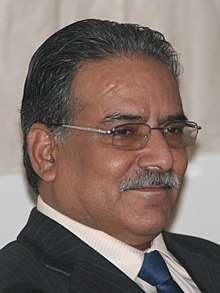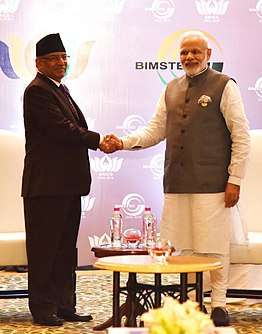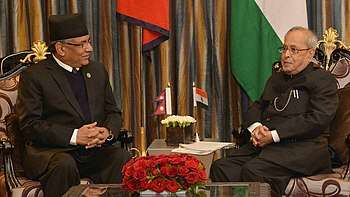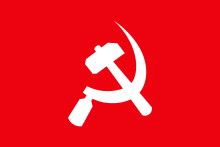Pushpa Kamal Dahal
Pushpa Kamal Dahal (Nepali: पुष्पकमल दाहाल, Nepali pronunciation: [ˈpuʂpʌkʌmʌl d̪aˈhal]; born 11 December 1954), commonly known by his nom de guerre Prachanda, is a Nepalese politician, Chairman of the Nepal Communist Party and twice Prime Minister of Nepal, from 2008 to 2009 and from 2016 to 2017.[1][2][3]
Pushpa Kamal Dahal पुष्पकमल दाहाल | |
|---|---|
 | |
| 33rd Prime Minister of Nepal | |
| In office 4 August 2016 – 7 June 2017 | |
| President | Bidhya Devi Bhandari |
| Preceded by | Khadga Prasad Oli |
| Succeeded by | Sher Bahadur Deuba |
| In office 18 August 2008 – 25 May 2009 | |
| President | Ram Baran Yadav |
| Preceded by | Girija Prasad Koirala |
| Succeeded by | Madhav Kumar Nepal |
| Chairman of the Nepal Communist Party | |
| Assumed office 17 May 2018 | |
| Preceded by | Position established |
| Personal details | |
| Born | Pushpa Kamal Dahal 11 December 1954 Dhikur Pokhari, Nepal |
| Political party | Nepal Communist Party (2018-present) |
| Other political affiliations | Communist Party-Fourth Convention (Before 1983) Communist Party-Masal (1983–1984) Communist Party-Mashal (1984–1991) Communist Party-Unity Centre (1991–1994) Communist Party-Maoist Centre (1994–2018) |
| Relations |
|
| Alma mater | Tribhuvan University |
| Website | Official website |
Dahal was leader of the Communist Party of Nepal (Maoist) during the country's civil war[4] and subsequent peace process which dissolved the monarchy and created a republic. In the 2008 elections CPN(M) emerged as the largest party, with Dahal becoming Prime Minister in August of that year.[5] He resigned as Prime Minister on 4 May 2009 after his attempt to dismiss the army chief, General Rookmangud Katawal, was opposed by President Ram Baran Yadav.[6]
Dahal is also widely known by his nom de guerre "Prachanda". In Nepali and other Indo-Aryan languages, the word Prachanda is an adjective that translates as "fierce".[7]
Personal life and early career
Prachanda was born into a Brahmin family[8][9] in Pokhara, a city in Kaski District,[10] some 243 kilometres (151 mi) west of Nepal's capital Kathmandu.[11][12][13] Prachanda spent much of his childhood in the Chitwan District. He received a diploma of science in agriculture (ISc-Ag) from Institute of Agriculture and Animal Science (IAAS) in Rampur, Chitwan, and was once employed at a rural development project in Jajarkot sponsored by USAID.[14]
Witnessing severe poverty amongst Nepalis since his youth, Prachanda was drawn to left-wing political parties. He joined the underground Communist Party of Nepal (Fourth Convention) in 1981.[15] He became general secretary of the Communist Party of Nepal (Mashal) in 1989. After several iterations, this party became the Communist Party of Nepal (Maoist). Prachanda lived in secret, even after the restoration of democracy in 1990. A little-known figure until then, he controlled the clandestine wing of the party, while Baburam Bhattarai represented the United People's Front in parliament.
Maoist insurrection

On 4 February 1996, Bhattarai gave the government, led by Nepali Congress Prime Minister Sher Bahadur Deuba, a list of 40 demands, threatening civil war if they were not met. The demands related to "nationalism, democracy, and livelihood" and included such line items as the "domination of foreign capital in Nepali industries, business and finance should be stopped", and "discriminatory treaties, including the 1950 Nepal-India Treaty, should be abrogated" (referring here to the 1950 Indo-Nepal Treaty of Peace and Friendship), and "land under the control of the feudal system should be confiscated and distributed to the landless and the homeless."[16] After that, and until 26 April 2006, Prachanda directed the military efforts of the CPN(M) towards establishing areas of control, particularly in the mountainous regions and in western Nepal.
The 40 demands were whittled down to 24 in subsequent political negotiations.[17]
Relationship with Baburam Bhattarai

In late 2004 or early 2005, relations between Prachanda and Baburam Bhattarai soured.[18] This was reportedly due to disagreement on power-sharing inside the party. Bhattarai was unhappy with the consolidation of power under Prachanda. At one point, Prachanda expelled Bhattarai from the party, though he was later reinstated.[19] They later reconciled at least some of their differences.[20][21]
.jpg)
After the king's direct action over the government on 1 February 2005, the CPN (Maoist) met in serious discussions over the future policy of the party. Until then, Comrade Prachanda, Comrade Kiran, and others were convinced that they would be able to rise to power just by having a dialogue with the king's government. Senior leader Bhattarai had rejected this idea of the party, ever since it came under discussion in the party. He insisted on joining with other 'mainstream' parties. He proposed working with other parties to abolish the monarchy and stressed that it was high time to work with other parties to establish a republic. He stated that the party should move ahead with a strategy of a democratic republic and a multi-party system for the time being, as the other parties would not accept a people's republic immediately. The majority of the other senior leaders had rejected his opinion from the beginning, including chairman Prachanda, and had made a decision to work together with the king.

Bhattarai and his supporters were punished and suspended for putting a view contrary to the party decision. But after the King's proclamation on 1 February 2005, the party realized that the policy they were pursuing was wrong. Immediately Bhattarai was released from his punishment and in a meeting held at Chunbang (a village in Rolpa) the party discussed Bhattarai's ideas. Subsequently, the party came forward with a strategy of a democratic republic rather than a people's republic.
Bhattarai's strategy has worked until now; it put forward the party as a major stakeholder in the nation's politics. Chairman Prachanda and Bhattarai seem to disagree with the strategy of the other senior leader—Mohan Vaidya alias Kiran. The two leaders agree to strengthen the newly established democratic republic, rather than implementing a people's republic immediately. They agree that the coming years will be a 'decade of economic revolution' that will change the country's economic profile. The relationship came to a crisis when Bhattarai was not given the second position in the government by Prachanda. But it seems settled after Bhattarai agreed to this decision by Prachanda.
Recently the relation between the two Maoist leaders became public, when Prachanda blamed India for supporting Bhattarai as future prime minister, and for trying to use him to create a struggle inside the party. Bhattarai claimed that this issue was raised with the intention of spoiling his reputation among the masses. Now Prachanda seems closer to Kiran, another prominent Maoist leader. But the row ended when Prachanda clarified that it was just a tactical game played against India.
Twelve point agreement
| Part of a series on |
| Maoism |
|---|
 |
|
People
|
|
Theoretical works |
|
History
|
|
Related topics |
|
On 22 November 2005, Prachanda and the Seven Party Alliance released a 'twelve-point agreement' that expressed areas of agreement between the CPN(M) and the parties that had won a large majority in the last parliamentary election in 1999. Among other points, this document stated that the dictatorial monarchy of King Gyanendra was the chief impediment to progress in Nepal. It claimed further that the Maoists were committed to human rights and press freedoms and a multi-party system of government. It pledged self-criticism and the intention of the Maoists and the Seven Parties to not repeat past mistakes.[22]
Ceasefires
Several ceasefires had occurred over the course of the Nepalese civil war.[23] Most recently, on 26 April 2006, Prachanda announced a ceasefire with a stated duration of 90 days. The move followed weeks of massive protests—the April 2006 Nepalese general strike— in Kathmandu and elsewhere that had forced King Gyanendra to give up the personal dictatorship he had established on 1 February 2005, and restore the parliament that had been dissolved in May 2002.
A new government was then established by the Seven-Party Alliance. The parliament and the new government supported the ceasefire and started negotiations with the Maoists on the basis of the twelve-point agreement. The two sides agreed that a new constituent assembly would be elected to write a new constitution, and decide the fate of the monarchy. The Maoists wanted this process to end with Nepal becoming a republic.[24]

Public appearance
In the first week of May 2006, Maoist chairman Prachanda along with another senior leader Dr. Baburam Bhattarai[25] entered Nepal through Birgunj, after presiding over a Maoist meet in Punjab, India. After this, they attended various programs organised by the party in different places. Prachanda refused to make a public appearance before there was a political settlement with the seven-party alliance. The Maoists were rigid in their demands that the monarchy was to be abolished, rather than just stripped of its powers. The Maoists looked at every activity of the new government with suspicion. Earlier, they had released a press statement that the king's plan for reinstating the parliament was a betrayal of the people.
Maoist leader Krishna Bahadur Mahara claimed that a secret agreement between the Seven-party Alliance and the king was reached on 24 April, in which they would ensure the king would retain monarchy in some form in the future. On 6 June 2006, Prime Minister Girija Prasad Koirala went to India for a four-day visit seeking support from India for Nepal's recent political changes. The Maoist chairman insisted they not ask for any economic assistance, without resolving the political disputes within the country, and demanded that the Maoist prisoners be released soon, who were languishing in Indian jails.
After the return of Prime Minister Girija Prasad Koirala to Nepal, he insisted on having high-level talks with Prachanda and Baburam directly. But chairman Prachanda and the other senior leader refused Koirala's request. They showed no willingness to go to Kathmandu. Home Minister Krishna Sitaula said,
- "After repeated persuasion, Prachanda and Baburam Bhattarai finally agreed. But before their public appearance, there was a lot more to do. So I flew in a helicopter without my security guards to meet them."
On the morning of 14 June, Sitaula flew in a private helicopter to Siklis, a mountainous village in Kaski district. When Sitaula reached there, the CPN (Maoist) was planning a mass meeting in the village. After having four hours of talks with the senior leaders, Sitaula finalised arrangements for their arrival in Kathmandu. On 16 June, Sitaula flew to Pokhara to receive Prachanda and Bhattarai. Prachanda along with his wife and Bhattarai were taken to the Prime Minister's residence. Maoist chairman Prachanda said, "That day, the first day I appeared in public in Kathmandu, I wore a light blue suit. I like light blue the most". It was a turning point in Prachanda's life after 25 years of life in hiding and 10 years of war.
There was an eight-point understanding between the government and the Maoist rebels. After talks with the Prime Minister, Prachanda spoke to the media that the peace talks were progressing despite the setbacks of the past. The public appearance of the rebel leader created a sensation in Nepal. The Maoist chief claimed that the understanding would give a new political direction to Nepal. Stating that the deal was "a historical one", Prachanda said that Nepal would soon be transformed into a republic after the Constituent Assembly elections. He was the first prime minister of Nepal after the monarchy was abolished.
Interim government
Prachanda met for talks with Prime Minister Girija Prasad Koirala on 16 June 2006, which was thought to be his first visit to the capital Kathmandu in more than a decade.[26][27] This meeting resulted in the Comprehensive Peace Accord to dissolve parliament, incorporate the CPN(M) into a new interim government, draft a new constitution, and disband the CPN(M)'s "people's governments" operating in rural Nepal. The two sides also agreed to disarm at a later date, under international supervision.[28] On 18 September 2007, the CPN(M) left the coalition government ahead of the Constituent Assembly election, demanding the declaration of a republic by parliament, and a system of proportional representation in the election. The CPN(M) rejoined the government on 30 December 2007 after an agreement to abolish the monarchy following the election, and to have a system of partial proportional representation in the election.[29]
During 3 February 2011 election for a Prime Minister, Prachanda had filed candidacy on behalf of the Communist Party of Nepal (Maoist-Centre), but later withdrew his candidacy and supported CPN-UML Prime Ministerial candidate, Jhalanath Khanal. With his support, Mr. Khanal was elected as the new prime minister, replacing Madhav Kumar's caretaker government of more than six months.
The path to power
The decade-long war ultimately led the Maoists to Nepal's parliament. After winning a remarkable majority in the Constitutional Assembly elections, Prachanda was nominated for the Prime Ministership by the party.[30] In the April 2008 Constituent Assembly election, he was elected from Kathmandu constituency-10, winning by a large margin, and receiving nearly twice as many votes as his nearest rival, the candidate of the Nepali Congress. He also won overwhelmingly in Rolpa constituency-2, receiving 34,230 votes against 6,029 for Shanta Kumar Oli of the Communist Party of Nepal (Unified Marxist-Leninist), CPN(UML).[31] With the CPN(M) appearing to have won the election, Prachanda pledged that the party would work together with other parties in crafting the new constitution, and he assured the international community, particularly India and China, that the party wanted good relations and co-operation. He also said that the party had expressed its commitment to multi-party democracy through the election.[32]
Following power-sharing discussions that lasted several months, Prachanda was elected as Prime Minister by the Constituent Assembly on 15 August 2008 and he was sworn in as Prime Minister on 18 August 2008.[33]
Relation with Mohan Baidya,"Kiran"
One of his political gurus and fellow traveller during ten years of civil war, Mohan Baidya, aka Kiran, fell out with him following some serious conflicts regarding whether the party should prepare for another civil war or continue with the traditional parliamentary system. Kiran was in favour of starting a new civil war whereas his president, Prachanda, along with Dr. Baburam Bhattarai advocated that the party should not deviate from the current parliamentary system and the party should be in the line of Peace and Constitution. Fuelled by several other conflicts such as,"disrespectful integration of PLA into Nepali Army", "dissatisfaction regarding the post in the cabinet", Mohan Baidya, along with some other senior leaders from the party, Ram Bahadur Thapa 'Badal', Dev Gurung, Netra Bikram Chand "Viplav", Pamfa Bhusal etc. declared a new party called "Nepal Communist Party-Maoist" and formally separated from Prachanda's "mainstream" Maoists.
Resignation and subsequent activities
Prachanda resigned from the post of Prime Minister on 4 May 2009, after his move to sack the Nepalese Chief of the Army Staff Rookmangud Katawal was opposed by President Ram Baran Yadav.[6] However, he remained in office until 23 May 2009, when his successor was elected.[34]
He was slapped in public by an ordinary citizen in November 2012.[35][36]
He was defeated by a Nepali Congress candidate, a little-known local activist named KC Rajan, by a large margin of around 8,000 votes in Kathmandu constituency No.10 in the November 2013 Constituent Assembly election. Five years earlier, in the 2008 Constituent Assembly elections, Prachanda had defeated the same candidate by 11,000 votes. Nevertheless, Prachanda won a seat in a different constituency. His political party won only 26 directly elected seats whereas it had won 120 seats in the 2008 election.
Second term as Prime Minister
In August 2016 Pushpa Kamal Dahal was elected for a second stint as Prime Minister of Nepal.[37] Prachanda became the 24th prime minister since Nepal's adoption of multi-party democracy in 1990 and the eighth since the abolition of the monarchy in 2008.[38] He resigned from the post of Prime Minister on 24 May 2017[39][40] and was succeeded by Sher Bahadur Deuba of the Nepali Congress in June.
References
- "Nepali Congress party president elected as 40th prime minister of Nepal - Xinhua | English.news.cn". news.xinhuanet.com. Retrieved 22 June 2017.
- "Pushpa Kamal Dahal 'Prachanda' Resigns As Nepal Prime Minister". NDTV.com. Retrieved 22 June 2017.
- Pokharel, Tilak; Sengupta, Somini (15 August 2008). "Nepal Elects a Maoist to Be the Prime Minister". The New York Times. ISSN 0362-4331. Retrieved 22 June 2017.
- "Nepal raises conflict death toll". BBC. 22 September 2009. Retrieved 24 March 2018.
The revised death toll records at least 16,278 deaths during the conflict. The previous estimate was about 13,000.
- "Ex-rebels' chief chosen as Nepal's new PM", Associated Press (International Herald Tribune), 15 August 2008.
- "Nepal PM quits in army chief row". BBC News. 4 May 2009. Retrieved 4 May 2009.
- "Prachanda". Encyclopædia Britannica. Retrieved 27 July 2016.
In 1980 Prachanda (a nom de guerre meaning "fierce") was tasked with...
- "CPN Maoist Chairman Pushpa Kamal Dahal elected as 39th Prime Minister of Nepal". Xinhuanet. Retrieved 13 December 2017.
- "Prachanda elected Prime Minister of Nepal". The Hindu. Retrieved 13 December 2017.
- "Profile: Prachanda, from commander to prime minister." Chinaview.cn, 15 August 2008
- Nepali PM Prachanda Sworn In. English.cri.cn. Retrieved 3 September 2011.
- "It will be nostalgia time for Prachanda in India". Archived from the original on 17 June 2011. Retrieved 28 October 2015.. news.indiainfo.com. 13 September 2008
- Prachanda’s family calls Archived 25 July 2011 at the Wayback Machine. Nepali Times. Retrieved 3 September 2011.
- Somini Sengupta, and he was also a high school teacher in Aarught of Gorkha district."Where Maoists Still Matter", The New York Times, 30 October 2005.
- Archived 3 December 2008 at the Wayback Machine
- Baburam Bhattarai, "40 Point Demand", South Asia Intelligence Review, 4 February 1996
- "Maoists Demand Interim Constitution," Archived 27 September 2008 at the Wayback Machine Kathmandu Post, 28 April 2003
- Singh Khadka, "Nepal's Maoist leadership divisions", BBC News, 6 May 2005.
- "Official expelled from Maoist party". Television New Zealand. 15 March 2005. Retrieved 4 November 2011.
- Charles Haviland, "Meeting Nepal's Maoist leader", BBC News, 16 June 2005.
- Sanjay Upadhya, "Nepal: Maoists hide more than they reveal", Scoop, 16 February 2005.
- Unofficial translation, "The 12-point agreement between the Maoists and the seven-party alliance as listed in statement by Pushpa Kamal Dahal on Tuesday," Archived 29 August 2008 at the Wayback Machine Nepal News, 25 November 2005
- Kamala Sarup (ed.), "Maoists declare three-month long ceasefire," Archived 17 July 2011 at the Wayback Machine Peace Journalism/Nepal News, 3 September 2005
- "Nepal Maoist rebels declare truce," BBC, 27 April 2006
- "Profile: Prachanda, from commander to prime minister." Chinaview.cn, 15 August 2008
- "Maoists to join Nepal government," BBC, 16 June 2006
- "Power Play," Archived 12 January 2009 at the Wayback Machine The Times of India 3 November 2001
- Maseeh Rahman, "After a decade of fighting, Nepal's Maoist rebels embrace government," The Guardian, 17 June 2006
- "Nepal Maoists rejoin cabinet after monarchy deal," Reuters, 30 December 2007
- "Nepal Maoists want their chief as president", Reuters (AlertNet), 25 January 2008.
- "Prachanda wins from Rolpa-2 as well", Nepalnews, 13 April 2008.
- "'We want to continue working with parties and the int'l community,' says Prachanda.", Nepalnews, 12 April 2008.
- "PM Dahal sworn in", Nepalnews, 18 August 2008.
- AFP: Nepal parliament elects new PM. Google.com (23 May 2009). Retrieved 3 September 2011.
- "Nepal's most powerful politico, Prachanda slapped in public - Indian Express". www.indianexpress.com. Retrieved 8 September 2018.
- Prachanda slapped by commoner at Maoist tea party Archived 5 November 2013 at the Wayback Machine
- Chaudhury, Dipanjan Roy (4 August 2016). "New PM Prachanda will bring Indo-Nepal ties back on track, hopes India". The Economic Times.
- "Maoist chief Prachanda elected as Nepal prime minister". The Times of India. Reuters. 3 August 2016.
- "Nepalese PM announces resignation - Xinhua | English.news.cn".
- "Prachanda resigns as Nepal Prime Minister making way for Sher Bahadur Deuba to take over". Retrieved 8 September 2018.
External links
| Wikimedia Commons has media related to Prachanda. |
- Prachanda's address to the 63rd session of the United Nations General Assembly, 26 September 2008
- BBC news Video Interview with Prachanda
| Party political offices | ||
|---|---|---|
| Preceded by Mohan Vaidya |
Leader of the Communist Party-Mashal 1986–1991 |
Succeeded by Narayan Kaji Shrestha as Leader of the Communist Party-Unity Centre |
| New office | Leader of the Communist Party-Maoist Centre 1994–present |
Incumbent |
| Political offices | ||
| Preceded by Girija Prasad Koirala |
Prime Minister of Nepal 2008–2009 |
Succeeded by Madhav Kumar Nepal |
| Preceded by Khadga Prasad Oli |
Prime Minister of Nepal 2016–2017 |
Succeeded by Sher Bahadur Deuba |

